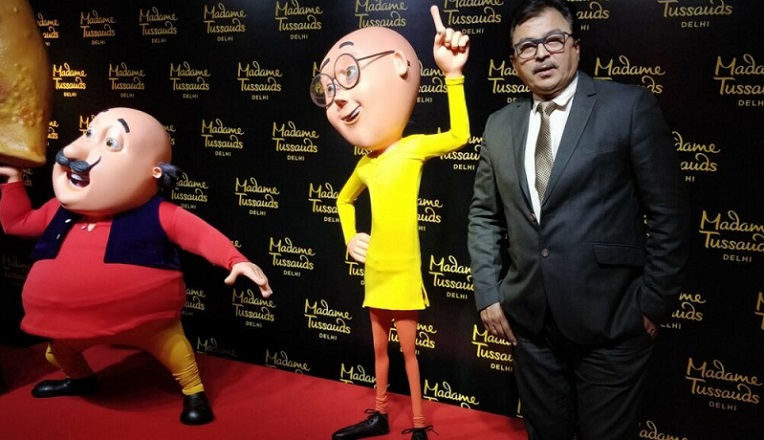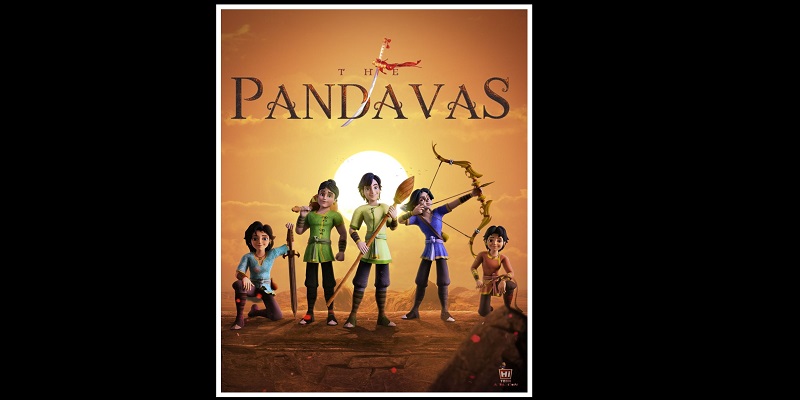
Having spent more than 25 five years in the media and entertainment industry, ex-army captain Niraj Vikram, has recently worked on the action-packed animated series The Pandavas which is currently being aired on Pogo as a writer and producer. Known for fantasy live-action TV series like Shaka Laka Boom Boom, Son Pari, Shararat Thoda Jaadu Thodi Nazaakat, and animated projects like Motu Patlu, Gattu Battu and so on, Vikram has donned the hats of a writer, producer as well as director.
AnimationXpress got in touch with the veteran writer to know more about his interesting background and journey so far in the M&E industry.
Commenting on the industry, Vikram said, “Indian animation has come a long way and is gradually moving towards varied content styles to cater to the tastes of the evolved audience.” He mentioned that he loves working on live action projects for the personal connections with the cast and crew, while the animated projects give him immense satisfaction as he can delve deep into the world of imagination.
Here are the excerpts from the interesting interview where the ex-army man shares how he pursued his passion and made a place in the industry. His journey as a writer is sheer inspiration for aspiring scriptwriters.
1. Having done LLB earlier and being an ex-army captain, how did you get into scriptwriting?
Writing was my hobby and passion. I used to write plays in school and college. So after leaving the army I came to Mumbai to join Bollywood.
2. Tell us about your journey till date as a writer.
I was born in Nagpur, I studied till graduation in Kanpur, Agra and a place called Sultanpur near Lucknow. I did my law in Raipur, Chhattisgarh. After leaving the army, I came to Mumbai to follow my passion and the initial years were full of struggle as I didn’t know anyone in Mumbai. It took me a couple of years to make contacts in the film industry and I started getting work. My first serial was All the Best on DD Metro produced by Adhikari Brothers. People loved that serial and after that I got to write a couple of more serials for Adhikari Brothers before moving on to other banners like UTV and many more. I have written for all big banners of Mumbai.
3. You have written scripts for TV shows like Son Pari, Shaka Laka Boom Boom, Shararat and so on. You have also worked on shows like Motu Patlu, Shiva Rudra, Daaduji, etc. Which one do you enjoy the most – live-action or animated projects? What are the basic differences?
Both have their own charm. Live-action has more personal connection as we go on shoot, interact with actors, technicians and it’s like a family working together. It’s more of a picnic and fun, whereas in animation, everything is done in studios where different vendors work on the same project from different places and once I hand over the script to the studio, I have no connection with what is happening with the script. However, animation has one big advantage, that is, you can stretch your imagination to any limits, you can write about anything in this universe and it can be made. But it’s not possible in live-action, so as a writer it gives you immense pleasure and satisfaction.
4. What are the elements to be considered while writing for animation? What are the most common mistakes in animation writing and how to avoid them?
There are many elements to be considered while writing for animated projects but two of the most important things are – firstly, let your imagination run wild, think of interesting, strange and impossible things which can’t be done in live-action, which is the advantage of animation. Secondly, detailing the brief of characters, locations, properties, because in live-action the director is there to explain the actors or art director but here whatever the writer writes in the script that has to be made. So the writer should explain in detail, every scene, character description, character’s expressions, props, etc as if he is directing and then only it can be made as the writer has visualized.
The most common mistake that writers make is that they forget the genre. Requirements for every genre are different and that has to be kept in mind.
5. What are the unique requirements, rules and responsibilities of a writer?
First, a writer should have command over the language in which he is writing. He should be a good observer, who can observe around himself in real life and pick up characters and situations. There can be a full lecture on this, in a nutshell I can say as a writer the first and foremost requirement is that you should be a dreamer. You should be able to dream of anything and put it on a paper, especially when you are a fiction writer. As far as responsibility is concerned, the main responsibility is towards the viewers and society. They shouldn’t write anything which will send a wrong message to viewers and society, especially to kids as they are the future of our country. Even while entertaining kids, a writer can give them good teachings/messages in a subtle manner, without being too preachy.
6. How has the writing evolved over the years? With shows being more inclusive and trying to address social issues, how are you keeping up with the changing times?
As viewers are exposed to different kinds of content from all over the world, the taste of the audience has also evolved, and the audience demands fresher and newer ideas. And that’s what presents both an opportunity and a challenge for the writers to experiment with different styles of writing and different subjects. And those writers who are not able to keep pace with this constant demand of the audience for unique ideas, they’ll be left behind.
In India we have always tried to underline the social skills and social issues both in TV series and movies, in an entertaining and subtle manner. And this trend will continue in future as well.
7. Can you share some of the best animated works that you have seen and been inspired by?
There are so many works like Finding Nemo, Lion King, Coco, Wall-E, UP, Hotel Transylvania, Toy Story, Madagascar etc.
8. Post pandemic, do you think, the current scenario is conducive to animation films all over the world?
Yes, it is. During the pandemic only the animation industry survived and the live- action industry was shut totally (for some time). Post pandemic all those who never thought of making animation films or TV series are also thinking of making animation movies and
TV series because it can be done from your home, pandemic or no pandemic animation industry will survive.
9. What is your observation on animation trends and the future of animation in India?
Indian animation has come a long way in the past two decades. From the time when one or two short TV movies of 45-60 min were commissioned by channels once in a year, to today, where all the lead shows on every kids channel is a local Indian show. Today every kids channel has three to four running Indian series at any given point of
time simply because the kids can relate with the characters and storylines much more than they can do with the shows acquired from abroad. Although there’s still acceptability and popularity of acquired shows like Ninja Hattori, Oggy & the Cockroaches, Doraemon etc, but shows like Motu Patlu, Rudra, Shiva, Bhoot Bandhus have become household names amongst the kids audience. And there’s a constant demand for new storylines and characters amongst the kids.
Today, with so much exposure to both international and local content, kids are looking forward to storylines and plots which they have not seen so far. While comedy continues to be the most popular genre amongst kids, they are willing to experiment with the genres and story plots that they have not viewed before. While it’s been almost over two decades that Indian animation got its own dedicated platform in kids’ channels, it still has a long way to go. Animation as a medium is so far looked upon only for kids; it has not made inroads amongst youth and adults in India. And that will be its next stage of growth.
10. With an increase in demand for content, how do you manage to deliver fresh and interactive content for kids’ shows?
I have my own team of writers, which keeps looking for fresh Ideas for every series and then I develop and discuss with them and make my final script.
11. What according to you is the importance of storyboarding in animation?
Storyboarding is a very essential part of animation. It gives a clear outline as to what is to be done. In storyboarding the entire script is drawn on panels, and then the animator interprets from storyboard and gives life to characters and properties and backgrounds. It gives the idea of what can be done, which route to take and in what limits.
12. From a global point of view, what do you think of the animation community? Do they focus more on the execution techniques or coming up with new storytelling styles? Is it any different here in India?
From the global point of view, the animation community has constantly evolved the art and style of storytelling and that’s one of the reasons why we see exploration of various genres and subjects along with a different style of animation. Studios in India are making similar attempts but they have been far and few. Hopefully now with the audience accepting and willing to experiment with new genres, we will see a more varied content in India as well.
13. How does a writer safeguard his intellectual effort? What is the procedure for registering original scripts?
Writers have to become a member of Writer’s association and then register scripts online or manually with them.
14. What do you have to say about the AVGC task force formed by the central government? What are your expectations?
Animation, visual effects, gaming and comic industries are finally getting recognition by the central government. AVGC is a blessing for the animation industry; it can help the animation industry grow in every state of India. It can become the backbone of the animation industry of India. It can serve the global demand in animation and India can become the torch bearer in the animation industry of the world.
15. It would be great if you talk about some of the upcoming projects that you are working on.
I have a couple of upcoming projects in different channels. One of them is a chase comedy and the other is totally a family entertainer. My latest project is The Pandavas on Pogo, which I have written and produced both.
Superstar actor Salman Khan’s iconic character Chulbul Pandey recently made an exciting return in a brand-new avatar with Dabangg – The Animated Series on Disney+ Hotstar VIP. Written by Niraj Vikram, the comedy-adventure show is produced by Arbaaz khan and Cosmos Maya and can be watched on Cartoon Network also.


